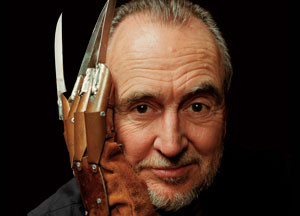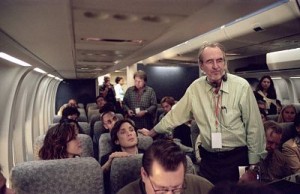 Check out Laurence’s vintage interview with the late filmmaker Wes Craven, director of the cult terror flicks The Hills Have Eyes (1977) and The Last House on the Left (1972), not to mention the horror favorites A Nightmare on Elm Street (1984) and Scream (1996) and its progeny. Laurence spoke with Wes in January, 2006 on the eve of the DVD release of his well-received 2005 thriller, Red Eye.
Check out Laurence’s vintage interview with the late filmmaker Wes Craven, director of the cult terror flicks The Hills Have Eyes (1977) and The Last House on the Left (1972), not to mention the horror favorites A Nightmare on Elm Street (1984) and Scream (1996) and its progeny. Laurence spoke with Wes in January, 2006 on the eve of the DVD release of his well-received 2005 thriller, Red Eye.
Disc Dish: Listening to your commentary tracks and featurette contributions on Red Eye and other films, it’s obvious you enjoy talking about your work.
Wes Craven: I suppose it’s the one area where I feel that I’m completely articulate. When I don’t know things, I keep my mouth shut. Commentaries are a lot of fun–I do them with my producer and my editor, Patrick Lussier, because they have excellent memories and I’m always forgetting people’s names and things like that. Also, I’m an ex-teacher, and it feels like DVD commentaries have brought film schools to everyone. Every fan is now able to hear commentaries on the technical side of filmmaking, the emotional side, on everything. I think it’s a good thing.
DD: What did you used to teach?
Craven: I taught Humanities at Westminster College in Pennsylvania, which was a one-year course, and then I taught freshman English and Modern Drama every once in a while. I had no idea I was going to get into the film business. It came over me in one year and I quit my job and went to New York and managed to get into the business.
DD: You’ve probably heard this before, but as you’re one of Hollywood’s leading horror filmmakers—and now a thriller filmmaker with the success of Red Eye—it’s a little surprising to hear how calm and relaxed you are.
Craven: (laughs) Yes, I’ve been hearing that for years! I think that’s based on a misperception on what horror is, and what horror directors do. It’s not like they’re directing horrible things out of their own pasts—I think they’re much more in touch emotionally with the horrors of the world, particularly as they’re perceived by them through their teens. They tend to be very gentle, happy, fun people. I think I’ve met them all the big ones by now—George Romero, John Carpenter, Tobe Hooper and the rest—and they’re all very sweet people.
DD: Horror directors tend to get classified and restricted to their genre pretty quickly in Hollywood. Do you fall into that category?
Craven: I think that used to be the case. Certainly, Red Eye changes that feeling in myself. I’ve been having that kind of perception shift over the past couple of years. I think somewhere along the line, people probably recognized that ‘this guy is a director and he can probably direct anything.’ The trick is to bring some of your core audience with you as you make each of your steps into another direction and you build a bigger audience.
DD: So many of your films are popular on home viewing staples on DVD— A Nightmare on Elm Street, the Scream series, The Hills Have Eyes. Are there any films that you’d like audiences to re-discover on DVD or enjoy for the first time if they missed them in their original incarnations?
Craven: Something that virtually nobody knows about are The Twilight Zone TV episodes from the mid-Eighties. I did seven of those and I’m very proud of them. There all with people who went on to be very big—Bruce Willis was in an episode before he started on Moonlighting. They’re from twenty years ago and now they’re available as a box set on DVD.
DD: That reminds me, last week Criterion put out a deluxe DVD version of Ingmar Bergman’s The Virgin Spring, which was the basis for your notorious 1972 film The Last House on the Left. I was surprised that in all of the extensive supplements, there isn’t a single mention of your film.
Craven: (laughs) You’re surprised? I’m not! I was in a meeting with a Hollywood executive one day and I mentioned The Virgin Spring because we were talking about Last House and he said ‘What’s that?’ So I actually turned him onto it and now he says he’s going to rent it.

Leave a Reply